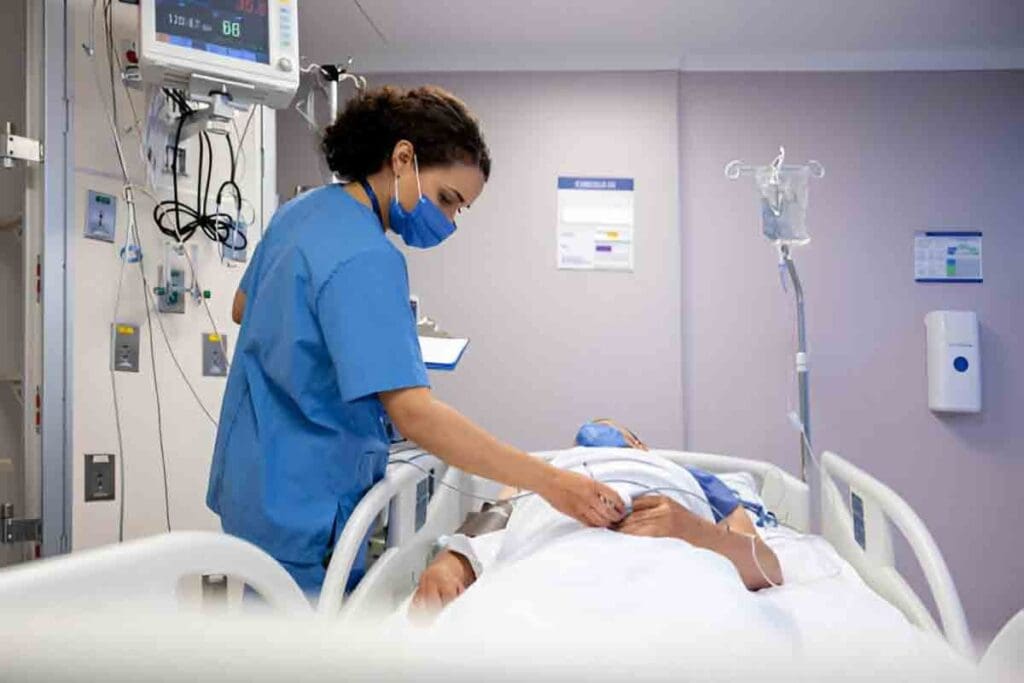Last Updated on November 26, 2025 by Bilal Hasdemir

Spinal anaesthesia, also known as spinal block anesthesia, is a common method for surgeries below the waist. It provides quick and effective pain relief.Worried about the side effects of spinal anaesthesia? Learn 12 common side effects and what you really need to know before your procedure.
At Liv Hospital, we put patient safety and transparency first. We ensure you get the best care at every step. Knowing the possible complications of spinal anaesthesia is key to making smart choices before surgery.
While spinal anaesthesia is mostly safe, some patients might face issues like low blood pressure, nausea, dizziness, urinary retention, and itching. These problems are usually manageable and don’t last long.

Spinal anaesthesia numbs specific body areas during surgery.
The process starts with the patient on their side or sitting up. The skin is cleaned, and a local anesthetic is used to numb the area. Then, a spinal needle is inserted between the ertebrae in the lower back.
The procedure requires precision and care to avoid complications. It takes a few minutes, and the anesthesia’s effects are felt soon after.
It’s used for surgeries like cesarean sections, hip replacements, and knee surgeries. It’s good for patients who can’t have general anesthesia.
The choice to use spinal anaesthesia depends on the surgery, patient health, and personal preferences. The anesthesiologist weighs the benefits and risks to decide the best anesthesia plan.
| Surgical Procedure | Use of Spinal Anaesthesia |
| Cesarean Section | Commonly used to provide pain relief during delivery |
| Hip Replacement | Frequently used to numb the lower body |
| Knee Surgery | Often utilized for effective pain management |

It’s important for patients to know about the side effects of spinal anaesthesia. This method is used for many surgeries. While it’s safe, it can cause some common side effects.
Side effects from spinal anaesthesia vary in frequency. Common ones include low blood pressure, nausea, and dizziness. These happen because the anaesthetic affects the body’s functions.
Hypotension, or low blood pressure, is a common side effect. It happens in a large number of patients. Nausea and vomiting also occur often, usually with hypotension.
| Side Effect | Frequency |
| Hypotension | 40-50% |
| Nausea and Vomiting | 20-30% |
| Dizziness | 10-20% |
Some factors can make side effects from spinal anaesthesia more likely. These include the patient’s health, age, and the surgery type.
Older adults and those with heart problems are at higher risk for hypotension. Also, if you’ve had nausea and vomiting before, you might get them again.
Knowing these risk factors and side effects helps doctors take better care of patients. This way, they can reduce the chance of complications.
Hypotension, or low blood pressure, is a common side effect of spinal anesthesia. It happens because the anesthesia blocks the nerves that control blood pressure. This blockage causes blood vessels to widen, leading to a drop in blood pressure.
Spinal anesthesia blocks the nerves that help control blood pressure. This blockage makes blood vessels widen. As a result, blood pressure drops.
The body’s blood pressure system is affected by spinal anesthesia. It blocks the nerves that keep blood vessels tight. This makes blood vessels widen, which lowers blood pressure. People with high blood pressure or who don’t have enough blood are more affected.
It’s important to manage hypotension during and after spinal anesthesia. The first step is to make sure the patient is well-hydrated. Giving intravenous fluids before or during the procedure can help.
Vasopressors are also used to manage hypotension. These medicines help blood vessels constrict and increase blood pressure. The type of vasopressor and when to use it depend on how low the blood pressure is and the patient’s overall health.
Keeping a close eye on the patient’s blood pressure is key. This allows for quick action if hypotension happens. Understanding why hypotension occurs and how to manage it helps reduce risks from spinal anesthesia.
After a spinal block, many patients feel nauseous and vomit. These symptoms can make recovery harder.
Hypotension, or low blood pressure, often happens after spinal anaesthesia. It can cause nausea and vomiting. This is because blood flow to the brain and vital organs is reduced.
When blood pressure falls, the body can’t always keep up. This leads to these uncomfortable symptoms.
To avoid nausea and vomiting after a spinal block, several steps can be taken. Preloading with fluids before the procedure can help. Giving vasopressors can also keep blood pressure stable. It’s also important to avoid excessive sedation and make sure the patient stays adequately hydrated.
Here are some ways to treat nausea and vomiting:
Spinal anesthesia can sometimes lead to post-dural puncture headache. This headache is caused by the dura mater being punctured during the procedure.
The main reason for post-dural puncture headache is cerebrospinal fluid (CSF) leakage. This happens when the dura mater is punctured. The brain then moves in the skull, causing pain.
Several factors can increase the risk of getting this headache. These include:
There are different ways to treat post-dural puncture headache. First, doctors might suggest:
If the headache is severe, an epidural blood patch might be needed. This involves putting the patient’s blood into the epidural space to stop the leak.
How long a post-dural puncture headache lasts varies. Some people get better in a few days, while others may take weeks. Luckily, most people don’t have lasting problems.
Doctors should keep a close eye on patients. They need to help manage symptoms and know when to seek more help.
Urinary retention is a common problem after spinal anesthesia. It affects many people and can be very uncomfortable. It’s important to manage it well to avoid more issues.
Urinary retention happens because spinal anesthesia blocks the nerves that control the bladder. Spinal anesthesia stops the nerves that make the bladder work properly, causing trouble with urination. This can make it hard to pee, and sometimes a catheter is needed.
A study in a medical journal said that how bad the block is and how much anesthetic is used matter.
“The sympathetic block caused by spinal anesthesia affects the normal functioning of the bladder, leading to urinary retention.”
| Factors Influencing Urinary Retention | Description |
| Level of Sensory Block | The higher the level of sensory block, the greater the risk of urinary retention. |
| Dose of Local Anesthetic | Higher doses of local anesthetic increase the risk of urinary retention. |
How long it takes for the bladder to get back to normal after spinal anesthesia varies. Usually, bladder function gets better once the spinal anesthesia wears off. But sometimes, it can take longer, and more care is needed.
A study showed that most people get their bladder working right again within 24 hours. But some might have trouble for longer, needing more medical help.
In summary, urinary retention and bladder problems are big issues after spinal anesthesia. Knowing how these problems happen and how long they last helps doctors take better care of their patients.
Spinal anaesthesia can cause pruritus, or intense itching. This is more common when opioids are used with spinal anaesthesia.
Pruritus can make patients uncomfortable and affect their recovery. It’s important for healthcare providers to know why it happens and how to treat it.
The exact reason for pruritus after spinal anaesthesia is not known. But it’s thought to be linked to opioid receptors in the brain. When opioids are given into the spinal canal, they can cause itching, mainly on the face, neck, and upper body.
Several things can make pruritus more likely:
It’s key to manage pruritus well to keep patients comfortable. There are several ways to do this:
Healthcare providers need to judge how bad the itching is and pick the best treatment. This depends on the patient’s situation and medical history.
“The management of pruritus after spinal anaesthesia requires a multifaceted approach, considering both the cause and the severity of the itching.”
– Expert in Anaesthesiology
In summary, pruritus can be a problem after spinal anaesthesia, but there are ways to handle it. By understanding why it happens and using the right treatments, healthcare providers can make patients more comfortable and improve their recovery.
Spinal anaesthesia is usually safe, but some people might feel neurological side effects. These effects can be mild or severe and last for different lengths of time.
Transient neurological symptoms (TNS) cause pain in the lower back, buttocks, or legs after spinal anaesthesia. The exact reason for TNS is not known, but it’s thought to be linked to the local anaesthetic used and how the patient is positioned.
Risk factors for TNS include:
Many people experience backache and lower limb pain after spinal anaesthesia. These symptoms can come from the anaesthetic, the surgery, or existing health issues.
The table below shows what might cause backache and lower limb pain and how to manage them.
| Cause | Management Strategy |
| Local anaesthetic injection | Pain management medication |
| Surgical procedure | Physical therapy, pain management |
| Pre-existing conditions | Pre-operative assessment, tailored anaesthetic plan |
How long neurological side effects last can vary a lot. Most TNS go away in a few days. But some backache and lower limb pain can last weeks.
Factors influencing the duration include:
Spinal anesthesia can lead to rare but serious side effects. These include nerve damage and infection. It’s important for patients to know about these risks.
Nerve injury is a risk with spinal anesthesia. It can happen if the nerve roots or spinal cord get damaged during the procedure. This damage can cause numbness, weakness, or paralysis.
Factors increasing the risk of nerve injury include:
Infection is a serious complication of spinal anesthesia. Bacteria in the spinal canal can cause meningitis, a dangerous condition. The risk is higher for those with weak immune systems or if sterile techniques are not followed.
Symptoms of meningitis include:
Arachnoiditis is a rare but serious condition. It’s caused by inflammation of the arachnoid membrane around the spinal cord. Symptoms include chronic pain, numbness, and tingling in the lower body.
Management of arachnoiditis typically involves:
It’s important to know when to get medical help after spinal anaesthesia. This can help prevent and manage any problems. Knowing the possible side effects and when to seek help is key to a smooth recovery.
Some symptoms after spinal anaesthesia need quick medical attention. These include:
If you have any of these symptoms, call your healthcare provider right away. As one doctor said,
“Quick action on complications can greatly improve patient results.”
Telling normal discomfort from complications can be tricky. Normal recovery usually means symptoms getting better slowly. But, if you see any of these, it might be a complication:
It’s always better to err on the side of caution when it comes to your health. If you’re not sure about your symptoms or how bad your discomfort is, don’t wait to call your healthcare provider for advice.
Knowing the warning signs and when to get medical help can make your recovery from spinal anaesthesia safer and more comfortable.
Spinal anaesthesia is a key method for managing pain during surgeries. It offers many benefits, like effective pain relief and quicker recovery times. But it also has some side effects to consider.
These side effects can range from mild issues like low blood pressure and nausea to serious problems like nerve damage and infections. It’s important for healthcare providers to understand these risks and find ways to reduce them.
Healthcare professionals need to carefully consider the benefits and risks of spinal anaesthesia. This helps them make the best decisions for their patients. It ensures patients get the most from spinal anaesthesia while keeping risks low.
In summary, spinal anaesthesia is a safe and effective option when used correctly. Its advantages can be greater than its drawbacks with the right patient care and management.
Spinal anaesthesia is a method to numb the lower body. It involves injecting a local anaesthetic into the spinal fluid. This blocks nerve signals to the brain, making the lower body numb.
Side effects include hypotension, nausea, vomiting, and headaches. You might also feel urinary retention, pruritus, and backache.
Hypotension happens because the anaesthetic blocks nerves that control blood vessels. This leads to vasodilation and a drop in blood pressure.
To manage hypotension, vasoconstrictors, fluids, and oxygen are given. The patient’s position is also adjusted to improve blood flow.
Hypotension can cause nausea and vomiting. This is because it reduces blood flow to the brain and gut.
Antiemetic medications can prevent and treat nausea and vomiting. Managing hypotension and ensuring hydration are also important.
Post-dural puncture headache occurs due to a leak of cerebrospinal fluid. It’s managed with pain relief, hydration, and sometimes an epidural blood patch.
Neurological side effects like backache and lower limb pain usually resolve in a few days to weeks.
Serious side effects include nerve injury, permanent neurological damage, infection, meningitis, and arachnoiditis.
Seek medical attention for severe headache, numbness or weakness in the legs, difficulty urinating, or severe back pain. Also, if you have a fever or signs of infection.
The time for spinal anaesthesia to wear off varies. It usually takes a few hours for the numbness to resolve.
Recovery time varies by individual and procedure. Most people can resume normal activities within a few days.
Subscribe to our e-newsletter to stay informed about the latest innovations in the world of health and exclusive offers!